Have you hit a wall with how to grow your ecommerce business?
We get it — scaling your digital business is an uphill battle. Driving traffic to your website is challenging enough, but converting visitors into leads or paying customers requires multiple touchpoints.
Not all ecommerce marketing campaigns are created equal, though. That’s why we’ve compiled the top growth strategies for every online business.
What Are the Best Ecommerce Marketing Strategies?
These tips will help you learn how to grow your ecommerce business. Let’s take a look at some strategies you can easily implement today for some quick wins:
- Add popup forms to your website
- Increase brand awareness
- Run (and optimize) Facebook retargeting ads
- Optimize your site for mobile
- Optimize your PPC ad campaigns and budget
- Generate customer reviews
- Implement a welcome email series to nurture prospects and customers
- Retarget customers who have abandoned their cart
- Launch a post-purchase email series
- Re-engage with customers who no longer open your emails
1. Add popup forms to your website
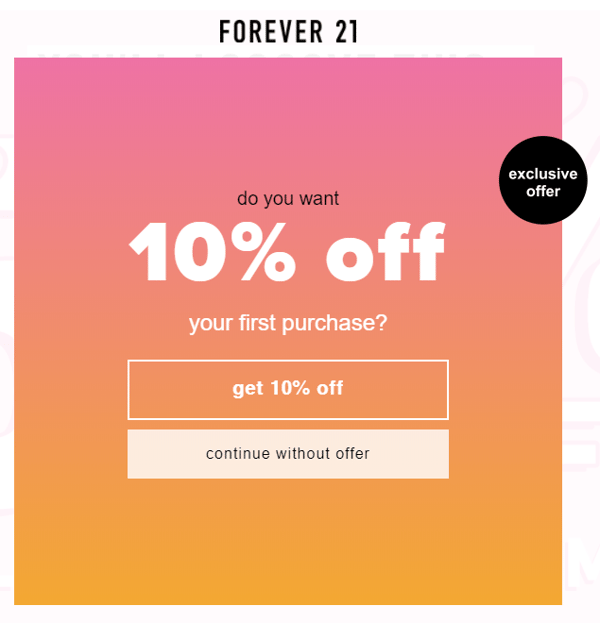
Use popup forms to ask visitors for their email address in exchange for a discount, free shipping offer or gift. Drum up quick sales from new visitors, or get them in your database so you can nurture them until they’re ready to purchase.
Here are a few ways to engage your visitors through popup forms:
- Offer welcome discounts
- Offer exit-intent discounts
- Promote your current sale
- Send a surprise or coupon code on their birthday
- Encourage signups for email newsletters
- Encourage signups for SMS campaigns
- Promote a contest or giveaway
Sure, you might be thinking: "But I already have an email subscription at the bottom of my website. I don't need an annoying popup form!"
Research shows that popup forms still work. Let's take a look at some real-world statistics to understand why popup forms are still effective for your ecommerce sales strategy.
Here at Human, we implemented a popup form for one ecommerce client and analyzed the results. Here’s what we found:
- 92% of new email contacts came from the popup form.
- 8% of new email contacts came from the standard email subscription form at the bottom of the page.
In another study, the folks at Sumo analyzed nearly two million popup forms and calculated an average popup form conversion rate of 3.09%.
A 3.09% conversion rate might seem small. But even if you’re only getting 100 website visitors per day, you’d still get 117 new leads every month!
You simply can't afford to ignore these numbers. Popup forms are easy to set up, and require minimal effort to manage once you turn them on. Don’t miss out on an easy opportunity to earn more leads and revenue.
The Bottom Line:
- Add popup forms to engage with new visitors.
- Offer a discount or something of value in exchange for their email address.
- Not having a popup form on your website to capture leads = a missed opportunity.
2. Create a recognizable brand
People buy on emotion. And a compelling, memorable brand story and appearance can help push more customers from passive visitors to raving fans.
Here are some essential brand-building tactics to get you started:
- Select your brand voice. Do you want to be known as serious and sophisticated or fun and playful? The way you communicate with your customers on social media, ads and email should reflect your desired voice.
- Determine your color scheme. The same way you can recognize a Coca-ColaⓇ bottle from half an aisle away, customers can learn to recognize your brand. Consistency is key, so whatever you pick, stick to it across all channels.
- Join the conversation. Get found where potential customers are looking for solutions like yours. Answer questions on forums like Quora to showcase your industry knowledge and authority. Take polls on social media to engage with your audience and get to know them better. Or, offer giveaways to create buzz about your products or services.
The Bottom Line:
- Keep your voice and visuals consistent to build recognizability.
- Use your social media platforms to talk to your customers, not just to post and share content.
3. Run Facebook retargeting ads

Remember that one time you looked up how much a pet hermit crab costs?
Well, the internet remembers — that’s why you can't stop seeing hermit crab ads on Facebook. Ads for crabs everywhere.
It’s not magic. The hermit crab website you visited had a tracking pixel on it. It used cookies to follow you via Facebook ads.
People rarely buy from a website the first time they visit it. With Facebook retargeting, you can advertise to people who visit your site but leave without making a purchase.
Facebook retargeting helps you reach individuals who already demonstrated a degree of interest in your products. Once they see your ad, they might finally feel compelled to return to your website and click ‘add to cart.’
Not yet convinced? Statistics show that retargeting ads receive 76% more clicks than display ads and drive a whopping 1,046% increase in organic branded searches.
Realistically, not everyone will click on your ads. But the more often they see your brand name or products, the more likely they’ll remember you (or search for you) once they’re ready to buy.
Take note of these tips before you launch retargeting campaigns:
- The copy should focus on customer pain points or questions they may have about your product or business. Your retargeting audience is already aware of your brand, so there’s no need to reintroduce yourself.
- Showcase your product in action or demonstrate the product’s value so prospects can see what they’re missing.
- Promote exclusive offers or discounts they can’t find anywhere else on your website. Your offer might give them the final push they need to convert.
Check out our step-by-step guide to setting up Facebook retargeting and get started today.
The Bottom Line:
- Use Facebook retargeting ads to rekindle interest from prospective customers.
- Retargeting ads are also helpful for increasing brand awareness.
- Copy and creative should nudge potential buyers to take the last step and convert.
4. Optimize your site for mobile
Consumers are leaning more heavily towards smartphones to shop online while desktop browsing takes a back seat.
The proof is in the data. In 2018, online Black Friday shoppers accounted for 40% of sales in what has been traditionally a brick-and-mortar shopping day. The shift to online shopping is happening every day.
Optimizing the mobile experience isn’t a nice-to-have anymore. It’s a primary driver for growing your ecommerce business.
Have you reviewed your mobile website experience as a consumer? Evaluate the mobile experience by reviewing these items:
- Visuals: Are images cut off or loading slowly? Is the text large enough to read? Is it running off screen?
- Usability: Are your menu items visible and accessible? Are links large (and far enough from other links) so visitors can easily click them? Do forms adapt to the screen size?
- Loading Time: How quickly does your site load? Does your page jump around as content loads onto the screen?
These items all affect the user experience and are often the source of high bounce rates.
The Bottom Line:
- Browse your site from your smartphone and see how it performs; there may be obvious errors you can correct without much hassle.
5. Optimize PPC campaigns and budget
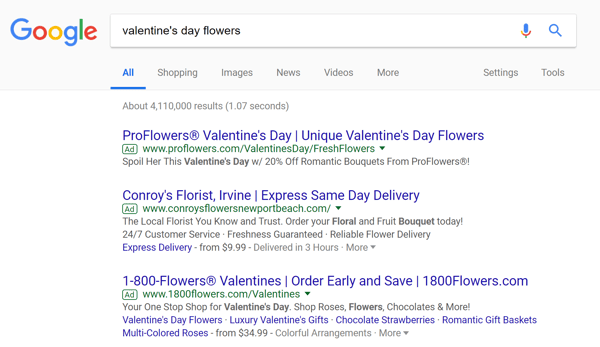
Retargeting ads and PPC (pay-per-click) ads are two sides of the same coin. Essentially, you spend money to nab digital real estate so you can drive traffic to your website.
Unlike organic search engine optimization (SEO), which can take months to years to see results, PPC lets you drive immediate traffic and revenue. But PPC campaigns can be very costly, especially if you aren’t testing or optimizing your campaigns regularly to ensure the best return on investment (ROI).
Here are a few ecommerce PPC tips you should know before diving in:
- Go slow. Google AdWords can be confusing at first, especially if you've never used the platform. Neil Patel has an excellent step-by-step guide to help you.
- Create a list of target keywords. Think of what users might type into Google to find businesses or products similar to yours. Evaluate your buyer personas, dig into Google Analytics or explore SEMrush to pinpoint the right keywords.
- Start with small bids. Depending on your industry and products, some keywords are expensive. Start small and see which keywords perform best.
- Watch your budget. PPC can get expensive quickly. While PPC campaigns can deliver immediate results, they can’t run on their own. Optimize your campaigns and track performance to ensure you aren’t wasting your money.
The Bottom Line:
- When it comes to PPC ads, you have to spend money to make money.
- Always monitor PPC spend closely, and don’t bid on expensive, competitive keywords if you’re just starting out.
6. Generate customer reviews
Leveraging social proof is a huge part of growing your ecommerce business.
When customers need to choose between two or more businesses that offer the same product or service, reviews are often the deciding factor. What if you all have 4.5 stars, you ask? The next tiebreaker is the number of reviews!
Would you trust the opinion of 5 people who rated a business highly? Or, would you trust the opinion of 250 people who cumulatively give a business a 4.5 star average? Hopefully, your answer is the latter!
Try these tactics to garner more reviews:
- Place reviews on your homepage and include a link for others to leave a review.
- Make an account on Yelp and Google Places.
- Contact customers who have recently purchased from you and ask them how they liked their purchase.
- Reward those who leave a review with a future discount or other perks.
The Bottom Line:
- Social proof is a powerful tool; use it to build trust, and it will help grow your business
7. Implement a welcome email series to nurture prospects and customers
Automated email marketing can save you a ton of time and effort. But we’re not just talking about order or shipping confirmation emails.
Workflows (also called automated email series or sequences) help nurture leads based on their browsing or purchase behaviors.
With a welcome series, your goal is to:
- Introduce your brand
- Thank new contacts for subscribing
- Let customers know what they can expect from you via email
Try including an introductory discount or offer, and nurture subscribers with inspiring brand stories, compelling testimonials and social proof or product recommendations.
The Bottom Line:
- Welcome emails set a precedent for what customers can expect from communications with you.
- Include incentives to purchase again in the future
8. Retarget customers who have abandoned their cart
Around 70% of website visitors abandon their online shopping carts. That’s a lot of missed potential sales.
Abandoned cart workflows target visitors who add items to their shopping cart but don’t complete the transaction. These emails typically have a very high open rate — about 43% or higher, with an average click rate of 21% and 10-11% conversion rate. Not bad!
Below are some examples of awesome abandoned cart emails.
This one from Kate Spade is bright, well-designed and to the point:
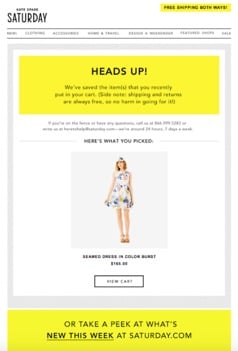
Millennial beauty brand Glossier goes for cheeky and funny — perfect for their young female audience.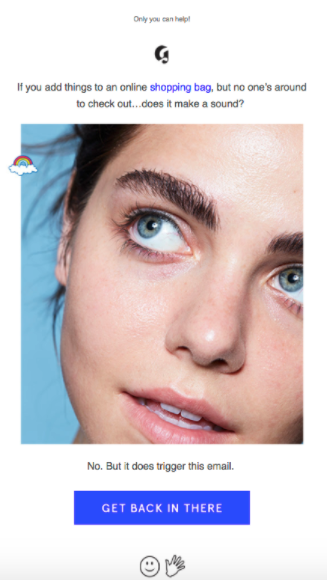
Google puts the pressure on with a clean, graphic design.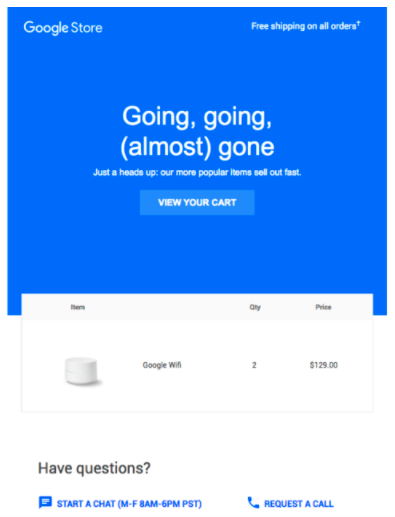
Most email marketing platforms like Hubspot, Klaviyo or Mailchimp have abandoned cart workflows that make setup easy.
The Bottom Line:
- Abandoned cart emails have a high open rate so your chances of returning that customer to the purchase process are very good!
9. Launch a post-purchase email series
Post-purchase series
After customers receive their items, follow up to request reviews or feedback, or cross-sell complementary products. You can even remind buyers to replenish their products.
Check out these examples of engaging post-purchase emails.
Sephora reminds you that you might be running out — it’s time to restock.

Fifteen days after delivery, Winc checks in to see how you’re enjoying your latest selection.
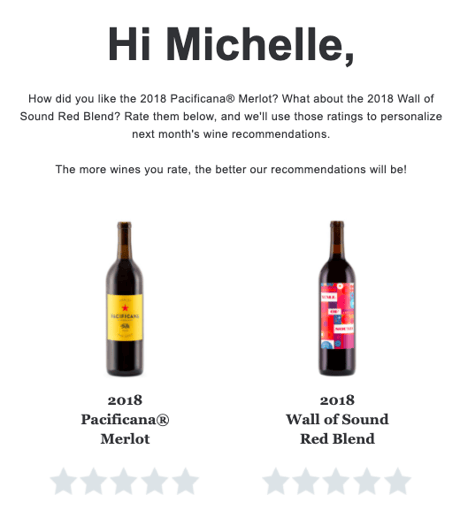
The Bottom Line:
- Use post-purchase emails to win another purchase with a gentle reminder to re-stock or to snag a valuable review.
10. Re-engage with customers who no longer open your emails
If you have stale contacts who no longer open or engage with your emails, consider adding them to a re-engagement workflow to rekindle their interest.
Subscribers often forget about the different emails they’ve signed up for, so it doesn’t hurt to nudge them and see if they’re still interested in receiving your messages. Here’s a good example from Udemy:

You can also grab their attention with a “we miss you” discount or offer to see if they’ll take the plunge.
The Bottom Line:
- Subscribers stop engaging for many reasons. Test their interest in reconnecting with an offer or “we miss you” email.
Energize Your Ecommerce Marketing Strategy
Following these tips will help you achieve quick wins for your ecommerce business. But if you’re serious about taking your ecommerce marketing strategy to the next level, you’ll want a dedicated team of digital marketing experts working alongside you.
Human is an award-winning digital marketing agency that specializes in growing traffic and revenue for ecommerce businesses.
We guide you through product launches, build your SEO and content strategy, leverage SMS marketing, enhance your social media presence and even develop, build and customize your Bigcommerce or Shopify store.



